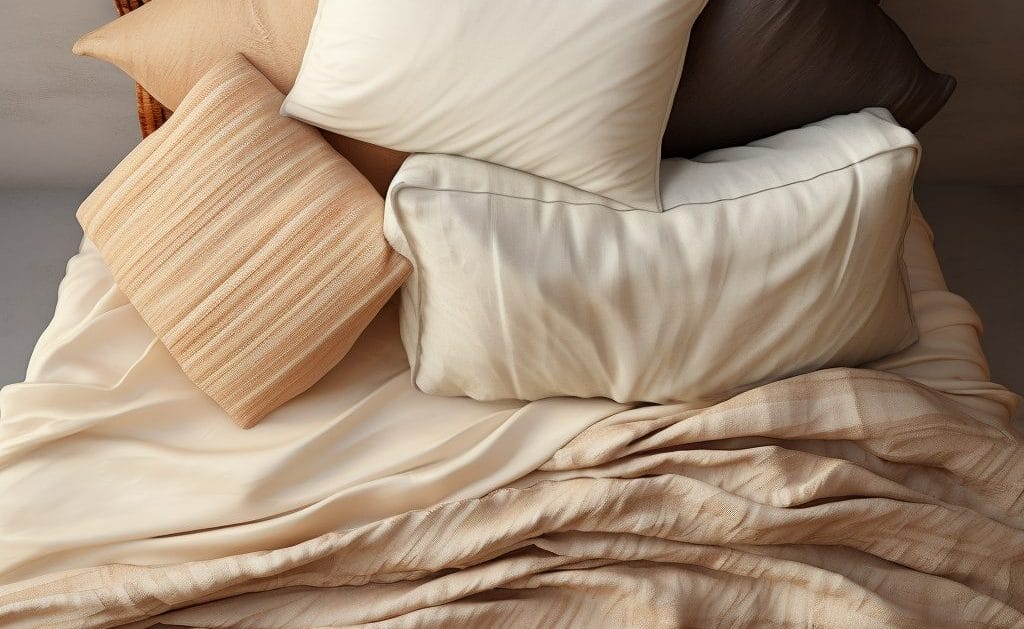What Bedding Material is Best? Exploring Your Options

When it comes to selecting the best bedding material, choosing the right one is like finding the perfect fit for a glove. With options like Tencel, cotton, linen, bamboo, and sateen, it’s essential to consider your specific needs and preferences.
Tencel, known for its moisture-wicking and breathability, is great for those who tend to sleep hot.
Meanwhile, cotton offers comfort and breathability, especially organic cotton for enhanced airflow.
Linen stands out for its exceptional breathability and moisture-wicking properties, while bamboo is favored for its hypoallergenic and breathable qualities.
Sateen provides a luxurious sleep experience, perfect for those desiring a touch of elegance.
Ultimately, your choice should consider material type, weave, and personal comfort preferences.

Tencel
If you’re looking for a natural, sustainable, and luxurious bedding material, Tencel is an excellent choice. Derived from eucalyptus trees, Tencel is highly praised for its lightweight and luxurious qualities, making it a popular choice for those seeking the best luxury bedding.
Tencel fabric is known for its moisture-wicking and breathable properties, making it particularly suitable for hot sleepers. Unlike cotton, Tencel sheets have an exceptional ability to soak moisture, providing a cool and comfortable sleep environment.
Additionally, Tencel is a durable material with excellent moisture-wicking properties, making it a great option for those looking for high-quality bedding.
When considering the best bedding material, Tencel stands out as a top contender due to its sustainable nature, luxurious feel, and superior performance compared to cotton.
Cotton
Cotton, a popular sheet fabric prized for its comfort and breathability, offers a variety of options for luxury bedding. When selecting cotton bedding materials, it’s essential to consider the thread count, which refers to the number of threads woven into a square inch. Higher thread count sheets are known for their smooth feel and durability.
For the ultimate luxury, consider Egyptian cotton, made from extra-long staple fibers, renowned for its exceptional softness and breathability. Additionally, the weave of the cotton fabric affects its feel and durability. Percale weave offers a crisp and matte finish, while sateen sheets have a smooth and lustrous surface. Both weaves are breathable and cool, making them excellent choices for luxury bedding.
Long-staple cotton is another desirable option, as it produces finer and stronger threads.
Now, let’s delve into the benefits of linen for bedding.
Linen
When choosing bedding material, consider linen for its exceptional breathability and moisture-wicking properties. Linen, a natural fabric that comes from the flax plant, is known for being the highest quality among bedding materials. The fabric that comes from French or Belgian flax is particularly renowned for its breathability and moisture-wicking abilities.
It’s important to note that linen is grown in the United States as well, making it a sustainable choice. While linen may wrinkle easily, it softens after multiple washings, making it a durable and comfortable bedding option. Linen is also hypoallergenic, making it suitable for sensitive skin. If you’re looking for sheets that prioritize breathability and moisture-wicking, linen might be the right choice for your needs.
Now, let’s explore the benefits of bamboo bedding.
Bamboo
You might consider bamboo as an ideal bedding material due to its hypoallergenic and breathable qualities. Bamboo is extracted from bamboo grass and is used to make sheets that are suitable for both summer and winter. Its breathability and moisture-wicking properties make it a popular choice for those who tend to sleep hot or have allergies.
Additionally, bamboo sheets with high thread counts are considered among the best bed sheets available. The material’s ability to absorb three times more water than its weight enhances comfort during sleep. When compared to organic cotton, bamboo sheets are softer and more breathable due to the natural fibers. This makes bamboo an excellent choice for those seeking a comfortable and hypoallergenic bedding option.
Moving forward, let’s delve into the benefits of ‘sateen’ sheets.
Sateen
One important factor to consider when choosing bedding material is the thread count of sateen sheets. Sateen, a type of cotton weave, is known for its luxurious appearance and breathability.
The thread count of sateen sheets refers to the number of threads woven into one square inch of fabric. Higher thread count cotton sateen sheets are generally smoother and more durable. They offer a soft, silky feel and a lustrous sheen, making them an excellent choice for those seeking a luxurious and comfortable sleep experience.
When compared to percale sheets, sateen sheets have a slightly heavier drape and a more subtle matte finish. Additionally, sateen sheets are versatile and can be used seasonally or permanently, depending on the climate. Whether it’s for hot or cool climates, sateen sheets are a popular choice due to their breathability and comfort.
Frequently Asked Questions
What Is the Best Bedding Material to Be Used?
For the best bedding material, consider Tencel for hot sleepers, linen for cool nights, bamboo for allergies and moisture absorption, organic cotton for breathability, and sateen for comfort and luxury. Each has unique benefits.
What Is the Best Bedding Made Out Of?
For the best bedding material, consider Tencel for hot sleepers due to its moisture-wicking and breathable properties, organic cotton for seamless airflow and comfort, linen for excellent breathability, bamboo for hypoallergenic and breathable qualities, and sateen for luxurious and cool sleep.
What Is the Best Bedding for Sleeping?
For a comfortable sleep, consider Tencel for moisture-wicking, bamboo for breathability, and linen for coolness. If you prefer a luxurious feel, sateen is a good choice. Organic cotton with longer fibers provides comfort and seamless airflow.
Which Fabric Bed Sheet Is Best?
For the best fabric bed sheet, consider Tencel for moisture-wicking and breathability, organic cotton for improved breathability and softness, linen for excellent breathability and moisture-wicking, bamboo for hypoallergenic and breathability, and sateen for cooling comfort.
Conclusion
In conclusion, when it comes to choosing the best bedding material for your needs, consider factors such as breathability, moisture-wicking abilities, and personal preferences.
Tencel, cotton, linen, bamboo, and sateen are all popular options, each offering unique benefits. Whether you prefer the moisture-wicking properties of Tencel or the luxurious feel of sateen, there’s a bedding material suited to your needs and preferences.
Ultimately, the best bedding material is the one that provides you with the comfort and sleep experience you desire.
